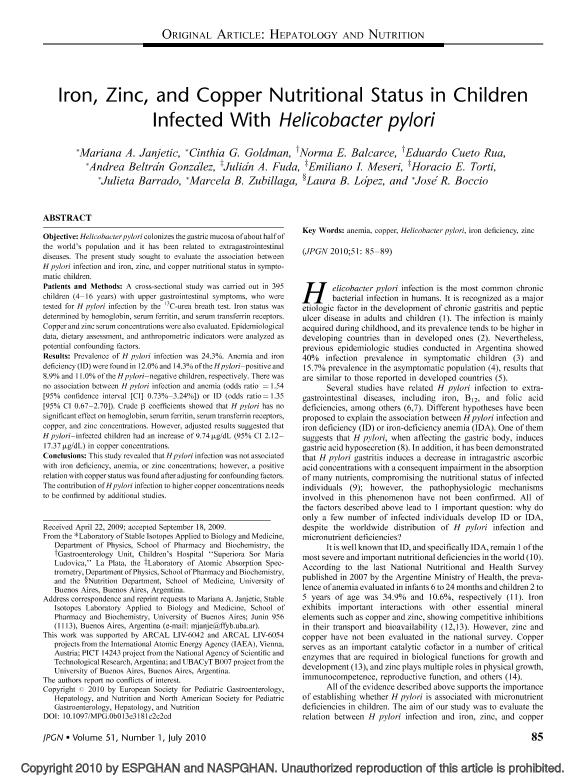Artículo
Iron, zinc, and copper nutritional status in children infected with helicobacter pylori
Janjetic, Mariana Andrea ; Goldman, Cinthia Gabriela
; Goldman, Cinthia Gabriela ; Balcarce, Norma E.; Rua, Eduardo Cueto; Beltrán González, Andrea Natalia
; Balcarce, Norma E.; Rua, Eduardo Cueto; Beltrán González, Andrea Natalia ; Fuda, Julián Andrés; Meseri, Emiliano I.; Torti, Horacio Emilio; Barrado, Julieta; Zubillaga, Marcela Beatriz
; Fuda, Julián Andrés; Meseri, Emiliano I.; Torti, Horacio Emilio; Barrado, Julieta; Zubillaga, Marcela Beatriz ; Lopez, Laura Beatriz; Boccio, Jose Ruben
; Lopez, Laura Beatriz; Boccio, Jose Ruben
 ; Goldman, Cinthia Gabriela
; Goldman, Cinthia Gabriela ; Balcarce, Norma E.; Rua, Eduardo Cueto; Beltrán González, Andrea Natalia
; Balcarce, Norma E.; Rua, Eduardo Cueto; Beltrán González, Andrea Natalia ; Fuda, Julián Andrés; Meseri, Emiliano I.; Torti, Horacio Emilio; Barrado, Julieta; Zubillaga, Marcela Beatriz
; Fuda, Julián Andrés; Meseri, Emiliano I.; Torti, Horacio Emilio; Barrado, Julieta; Zubillaga, Marcela Beatriz ; Lopez, Laura Beatriz; Boccio, Jose Ruben
; Lopez, Laura Beatriz; Boccio, Jose Ruben
Fecha de publicación:
07/2010
Editorial:
Lippincott Williams
Revista:
Journal Of Pediatric Gastroenterology And Nutrition
ISSN:
0277-2116
Idioma:
Inglés
Tipo de recurso:
Artículo publicado
Clasificación temática:
Resumen
OBJECTIVE: Helicobacter pylori colonizes the gastric mucosa of about half of the world's population and it has been related to extragastrointestinal diseases. The present study sought to evaluate the association between H pylori infection and iron, zinc, and copper nutritional status in symptomatic children. Patients and Methods: A cross-sectional study was carried out in 395 children (4-16 years) with upper gastrointestinal symptoms, who were tested for H pylori infection by the 13 C-urea breath test. Iron status was determined by hemoglobin, serum ferritin, and serum transferrin receptors. Copper and zinc serum concentrations were also evaluated. Epidemiological data, dietary assessment, and anthropometric indicators were analyzed as potential confounding factors. Results: Prevalence of H pylori infection was 24.3%. Anemia and iron deficiency (ID) were found in 12.0% and 14.3% of the H pylori-positive and 8.9% and 11.0% of the H pylori-negative children, respectively. There was no association between H pylori infection and anemia (odds ratio = 1.54 [95% confidence interval [CI] 0.73%-3.24%]) or ID (odds ratio = 1.35 [95% CI 0.67-2.70]). Crude β coefficients showed that H pylori has no significant effect on hemoglobin, serum ferritin, serum transferrin receptors, copper, and zinc concentrations. However, adjusted results suggested that H pylori-infected children had an increase of 9.74 μg/dL (95% CI 2.12-17.37 μg/dL) in copper concentrations. Conclusions: This study revealed that H pylori infection was not associated with iron deficiency, anemia, or zinc concentrations; however, a positive relation with copper status was found after adjusting for confounding factors. The contribution of H pylori infection to higher copper concentrations needs to be confirmed by additional studies.
Palabras clave:
Anemia
,
Copper
,
Helicobacter Pylori
,
Iron Deficiency
,
Zinc
Archivos asociados
Licencia
Identificadores
Colecciones
Articulos(INGEBI)
Articulos de INST.DE INVEST.EN ING.GENETICA Y BIOL.MOLECULAR "DR. HECTOR N TORRES"
Articulos de INST.DE INVEST.EN ING.GENETICA Y BIOL.MOLECULAR "DR. HECTOR N TORRES"
Citación
Janjetic, Mariana Andrea; Goldman, Cinthia Gabriela; Balcarce, Norma E.; Rua, Eduardo Cueto; Beltrán González, Andrea Natalia; et al.; Iron, zinc, and copper nutritional status in children infected with helicobacter pylori; Lippincott Williams; Journal Of Pediatric Gastroenterology And Nutrition; 51; 1; 7-2010; 85-89
Compartir
Altmétricas



